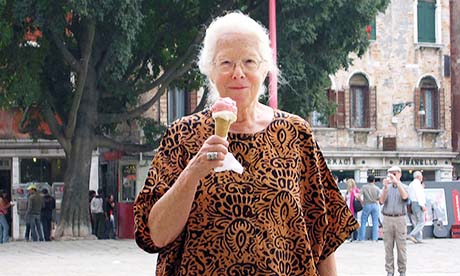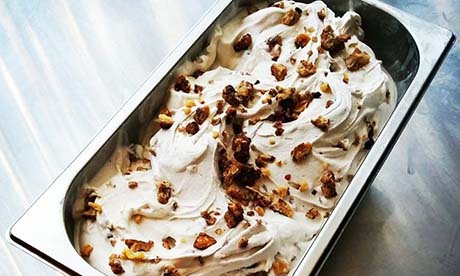The scoop: Hackney’s best ice cream
The lightbulb moment for Robin Weir was when he read, in mounting horror and revulsion, the list of ingredients in the tub of ice cream his small children had sneaked into the supermarket trolley. Back home he tipped the lot into the waste bin and then took the by now weeping infants out to purchase a state-of-the-art ice cream machine and some basic items: cream, fruit and sugar.
The rest is history. Lots of history. Armed with Elizabeth David’s Harvest of the Cold Months, Robin set to work to investigate how and when ice cream happened and what makes it so good. Decades later he and his wife Caroline published Ice Creams, Sorbets & Gelati – the definitive guide (Grub Street, 2010, £19.99). This is my bible, for here is the scientific explanation of what’s going on, the basic recipe and over 400 variations, and historical notes on the amazing story of how ices came to be, all illustrated with weird and wonderful items from his manic collection of prints, artefacts and memorabilia.
Ice and compacted snow have been used to chill food and drink for centuries all over the world, harvested in winter and stored in specially constructed buildings, well-ventilated and drained. Palaces and grand homes had their ice houses long before the 19th-century demand encouraged trade in ice with Nordic countries and as far away as Canada.
But nobody is sure about the breakthrough that brought us ice cream. Perhaps a careless or malicious kitchen boy allowed salt to get into the ice-filled cooler of his boss’s drink, or it was some scholar’s application of pure scientific reason to the physics and chemistry of the endothermic effect, or maybe in the stifling 17th-century Florentine summer a heat-crazed boffin at the court of Leopold de’ Medici, lusting after chilled soft fruit, steered the experiments of the Academia del Cimento in a voluptuous direction.
For what happened is that salt put into ice lowers the temperature dramatically, so anything liquid, a frothy custard or a sweetened fruit drink, immersed in the mixture, turns solid. Bingo.
And there you have it, long before refrigeration as we know it, ices were being made using simple equipment – a tub of ice and salt, and a pot to put in it, in Paris, Rome and Naples. It took an intrepid Englishwoman, Mrs Agnes B Marshall, to invent a wooden tub with a container and paddle that you could work with a handle, and make ice cream in a matter of minutes. I once saw one in action at the foot of the market cross in Selby, where in the post-war years ice cream was allowed after years of austerity. The maker was Italian, of course, and looking back I wish I could have found out what the ingredients were. For ‘homemade’ ice cream in Italy today, however beguiling, is something of a myth.
Propria produzione, fatta in casa, sounds good, ‘Our own produce, made on the premises’ is indeed made by the proprietor on his own premises – using kits of pre-prepared substances and an array of optional flavourings, colouring, emulsifiers, and stuff to stop it melting in the shop, all supplied by the multi-national ice cream industry. Just about the only ingredient that is not suspect is admittedly healthy, and costs nothing – fresh air – which can be whipped in to increase the volume of the product for free by almost a third. What a carry on.
Here in Hackney we can taste the good, the bad and the indifferent. Look out for good restaurants like Hackney City Farm, Number90 and The Hackney Pearl that make their own. Happy hunting, but with the same reservation we had for Mexican food: just acquire the gear and the ingredients and some basic recipes and get to work.
Marmalade Ice Cream
This is taken from page 189 of Robin and Caroline Weir’s book, with their permission. It is the easiest recipe of all, and always a success.
310 g or 1 American cup Seville orange marmalade
30 g or 1/8 cup caster sugar
500 ml or 2 cups whipping/heavy cream, chilled
1 – 2 tsp orange juice
Mix everything together except the juice (using processor or just stir together), adding some of the juice to taste. Freeze.
Parmesan Cheese Ice Cream
What makes this recipe from page 112 so tasty is the umami in the cheese, a natural flavour enhancer, so the effect is not ‘cheesy’, it’s simply delicious.
500 ml or 2 cups, whipping/heavy cream
115 g or ½ cup unrefined granulated sugar
115 g or 1 cup grated Parmesan cheese
Bring the cream to the boil with the sugar, stirring constantly, then remove from the heat and add the grated Parmesan, stirring until it melts. Allow to cool. Then scrape into a freezer box, cover, and freeze overnight. Note: this is a thick ice
that is unsuitable for churning.
Why should the ice-cream-besotted Hackney citizen bother about street names in Earl’s Court and Kensington? Well, as we struggle westwards to get to the M4 we languish on Talgarth Road, and flit past Tregunter Road, with a glimpse of Redcliffe Square or street names like Wetherby and Collingham, and find that these were named by the ice cream tycoon James Gunter, supplier of luxury confectionary to Regency toffs, as he developed the properties that he had once been shrewdly invested in as kitchen gardens and orchards. His origins were Welsh, and much of his wealth was invested in estates in Yorkshire, hence the street names. Who would have thought that vast swathes of posh London are quite literally built on ice cream?
One can only speculate that the shiploads of ice docking in the East End for businesses that needed it for refrigeration and luxury desserts, might have trickled down to local tradesmen in the East End, and been used by ambulant vendors, offering ‘penny licks’ at low cost to the masses.
Once, many decades ago, when I lived in Camden Town, I came across a skip in York Way, full of the sad remnants of an old-fashioned sweet-shop, and there among perilous shards of broken glass and lumps of rubble, I rescued half a dozen of those stout squat ‘penny lick’ glasses, with thick shallow bowls, disguising the tiny space on which to offer a small scoop of ice cream, making it look much bigger than it really was. These almost indestructible glasses were more practical than cones and wafers, but, well-licked and unwashed, desperately unhygienic, and so banned in 1926. I put table salt in mine, a safer option.


